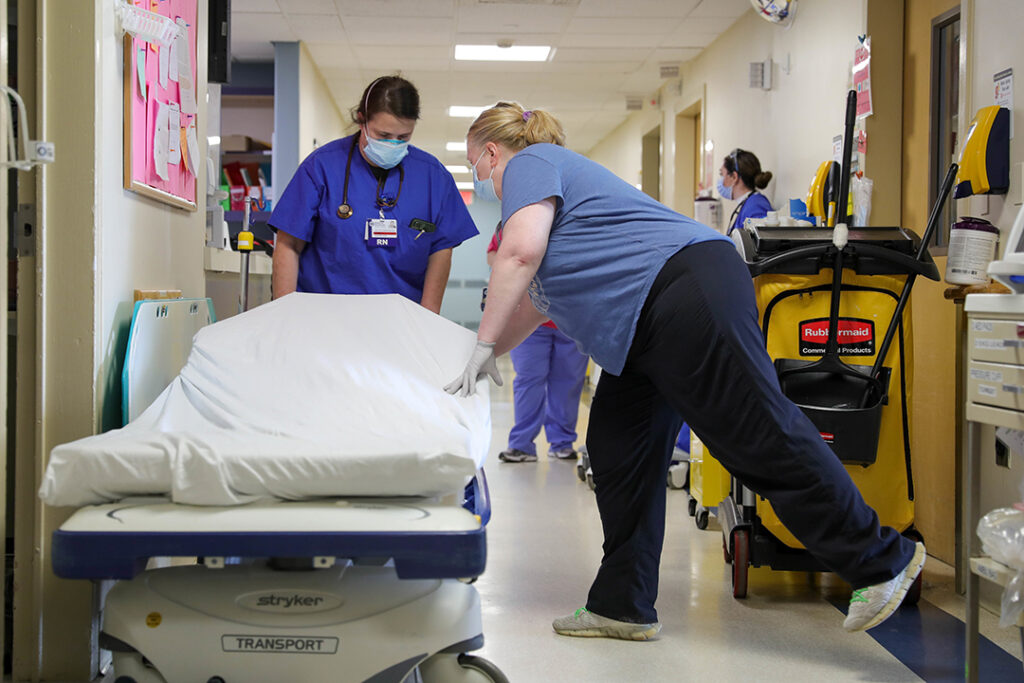THE ASSOCIATED PRESS
A COVID-19 patient was in respiratory distress, and the U.S. Army nurse had to act quickly.
It was the peak of this year’s omicron surge, and an Army medical team was helping in a Michigan hospital. Regular patient beds were full. So was the intensive care unit. But the nurse heard of an open spot in an overflow treatment area, so she and another team member raced the gurney across the hospital to claim the space first, denting a wall in their rush.
When she saw the dent, Lt. Col. Suzanne Cobleigh, leader of the Army team, knew the nurse had done her job. “She’s going to damage the wall on the way there because he’s going to get that bed,” Cobleigh said. “He’s going to get the treatment he needs. That was the mission.”
That nurse’s mission was to get urgent care for her patient. Now, the U.S. military mission is to use the experiences of Cobleigh’s team and other units pressed into service against the coronavirus pandemic to prepare for the next crisis threatening a large population.
Their experiences, U.S. Air Force Gen. Glen D. VanHerck said, will help shape the size and staffing of the military’s medical response so the Pentagon can provide the right types and numbers of forces needed for another pandemic, global crisis or conflict.
One of the key lessons learned was the value of small military teams over mass movements of personnel and facilities in a crisis like the one wrought by COVID-19.
In the early days of the pandemic, the Pentagon steamed hospital ships to New York City and Los Angeles and set up massive hospital facilities in convention centers and parking lots, in response to pleas from state leaders. The idea was to use them to treat non-COVID-19 patients, allowing hospitals to focus on the more acute pandemic cases. But while images of the military ships were powerful, too often many beds went unused. Fewer patients needed noncoronavirus care than expected, and hospitals were still overwhelmed.
A more agile approach emerged: having military medical personnel step in for exhausted hospital staff members or work alongside them or in additional treatment areas in unused spaces.
“It morphed over time,” VanHerck, who heads U.S. Northern Command and is responsible for homeland defense, said of the response.
Overall, about 24,000 U.S. troops were deployed for the pandemic, including nearly 6,000 medical personnel to hospitals and 5,000 to help administer vaccines. Many did multiple tours. That mission is over, at least for now. (Pictured: U.S. Air Force Maj. Tonya Toche-Howard, left, a registered nurse assigned to the U.S. Air Force military medical team deployed to Brockton, Massachusetts, pushes a hospital bed into a patient’s room in February 2022.)
Cobleigh and her team members were deployed to two hospitals in Grand Rapids from December 2021 to February 2022 as part of the U.S. military’s effort to relieve civilian medical workers. The last military medical team that had been deployed for the pandemic finished its stint in April 2022 at the University of Utah Hospital and headed home.
VanHerck said his command is rewriting pandemic and infectious disease plans, and planning wargames and other exercises to determine if the U.S. has the right balance of military medical staff in the active duty and reserves.
During the pandemic, he said, the teams’ make-up and equipment needs evolved. Now, he’s put about 10 teams of physicians, nurses and other staff — or about 200 troops — on prepare-to-deploy orders through the end of May in case infections rise again. The size of the teams ranges from small to medium.
Dr. Kencee Graves, inpatient chief medical officer at the University of Utah Hospital, said the facility finally decided to seek help because it was postponing surgeries to care for all the COVID-19 patients and closing off beds because of staff shortages.
Some patients had surgery postponed more than once, Graves said, because of critically ill patients or critical needs by others. “So, before the military came, we were looking at a surgical backlog of hundreds of cases and we were low on staff. We had fatigued staff.”
Her mantra became, “All I can do is show up and hope it’s helpful.” She added, “And I just did that day after day after day for two years.”
Then came a 25-member Navy medical team.
“A number of staff were overwhelmed,” said Cmdr. Arriel Atienza, chief medical officer for the Navy team. “They were burnt out. They couldn’t call in sick. We’re able to fill some gaps and needed shifts that would otherwise have remained unmanned, and the patient load would have been very demanding for the existing staff to match.”
IMAGE CREDIT: SPC. DANIEL THOMPSON/U.S. ARMY

